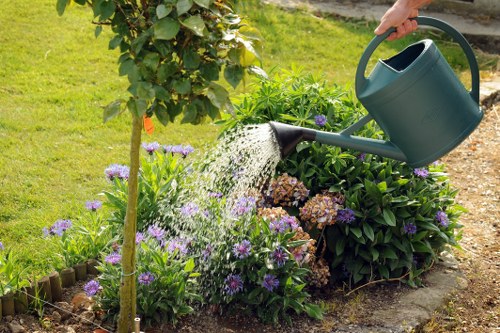Comprehensive Garden Maintenance for Successful Lawn Turf Installation
Introduction to Lawn Turf Installation

Installing a lush, green lawn begins with proper garden maintenance. Whether you're a seasoned gardener or a novice, understanding the essentials of lawn turf installation is crucial for achieving a healthy and vibrant garden.
Before laying down turf, it's important to prepare the soil, choose the right grass type, and implement effective maintenance practices. This article delves into the key aspects of garden maintenance that ensure successful lawn turf installation.
From soil preparation to watering techniques, we'll guide you through each step to help you create a beautiful and enduring lawn that enhances your outdoor space.
Understanding Soil Preparation
Soil quality plays a pivotal role in the success of turf installation. Proper soil preparation ensures that your lawn has the necessary nutrients and structure to support healthy grass growth.
Begin by removing debris such as rocks, roots, and weeds from the area. This creates a clean slate for your turf and prevents future growth of unwanted plants.
Next, till the soil to a depth of at least 6 inches. Tilling breaks up compacted soil, improving aeration and allowing roots to penetrate deeply.

Choosing the Right Turf
Types of Grass
Selecting the appropriate grass type is essential for the climate and usage of your lawn. Common varieties include Bermuda grass, Fescue, and Kentucky Bluegrass.
Bermuda grass thrives in warm climates and is drought-resistant, making it ideal for sunny areas. Fescue is well-suited for cooler climates and offers excellent shade tolerance.
Kentucky Bluegrass is known for its rich color and density, perfect for high-traffic lawns.
- Consider the climate of your region
- Assess the sunlight exposure in your garden
- Determine the level of foot traffic your lawn will endure

Installing the Turf
Proper turf installation is critical for establishing a resilient lawn. Follow these steps to ensure a smooth installation process:
Step 1: Layout
Begin by laying out the turf rolls in a staggered pattern, similar to laying bricks. This helps to prevent visible seams and creates a more natural appearance.
Step 2: Cutting and Fitting
Trim the edges of the turf using a sharp knife to fit around obstacles such as trees, paths, and flowerbeds. Ensure that pieces fit snugly without overlapping.
Step 3: Rolling and Watering
After laying the turf, roll it with a lawn roller to ensure good contact with the soil. Immediately water the lawn thoroughly to help the turf establish roots.
Tip: Water the newly installed turf daily for the first two weeks to promote root growth.

Ongoing Garden Maintenance
Maintaining your lawn after turf installation is essential for its longevity and beauty. Implementing a regular maintenance routine will keep your garden looking its best year-round.
Watering Practices
Proper watering is vital for maintaining a healthy lawn. Aim to provide your turf with about 1 inch of water per week, adjusting based on weather conditions.
- Water early in the morning to reduce evaporation
- Use a sprinkler system for even distribution
- Avoid overwatering, which can lead to shallow roots and disease
Mowing Techniques
Regular mowing encourages grass to grow thick and strong. Keep your mower blades sharp and never remove more than one-third of the grass blade at a time.
Optimal mowing height:
- Bermuda grass: 1-2 inches
- Fescue: 2.5-3.5 inches
- Kentucky Bluegrass: 2-3 inches

Fertilizing and Soil Care
Fertilizing provides essential nutrients that your lawn needs to thrive. Depending on the grass type, apply a balanced fertilizer in the spring and fall.
Additionally, consider aerating the soil annually to alleviate compaction and improve nutrient absorption. Aeration involves perforating the soil with small holes, allowing air, water, and fertilizer to penetrate deeply.
Top-dressing with compost can also enhance soil fertility and promote healthy grass growth.
Pest and Disease Management
Regularly inspect your lawn for signs of pests and diseases. Early detection allows for effective treatment before issues escalate.
- Identify common lawn pests such as grubs and chinch bugs
- Use organic or chemical treatments as necessary
- Maintain good lawn hygiene to prevent disease spread
Seasonal Maintenance Tips
Spring Care
Spring is the perfect time to rejuvenate your lawn. Rake away debris, aerate the soil, and apply a spring fertilizer to kickstart growth.
Summer Care
During the hot months, focus on watering deeply and less frequently to encourage deep root systems. Mow regularly and provide shade to prevent heat stress.
Fall Care
Prepare your lawn for winter by aerating, overseeding bare spots, and applying a fall fertilizer high in potassium to strengthen roots.
Winter Care
Minimize foot traffic on the lawn and remove any debris to prevent mold and fungal growth. Consider applying a winterizer to protect the grass during colder months.
Common Challenges and Solutions
Weed Control
Weeds compete with grass for nutrients and water. Implement weed control measures such as applying pre-emergent herbicides in the spring and manually removing weeds.
Thatch Buildup
Thatch, a layer of dead grass and roots, can inhibit water and nutrient absorption. Dethatch your lawn annually to prevent buildup and promote healthy growth.
Compacted Soil
Compacted soil restricts root growth and reduces oxygen availability. Use aeration techniques to alleviate soil compaction and improve lawn health.
Disease Prevention
Maintain proper lawn hygiene by promptly addressing issues like fungal infections and ensuring adequate ventilation through regular mowing and aeration.
Advanced Maintenance Techniques
Integrated Pest Management (IPM)
IPM combines biological, cultural, and chemical practices to manage pests sustainably. Focus on prevention through healthy lawn practices and use targeted treatments when necessary.
Soil Testing
Conduct regular soil tests to monitor nutrient levels and pH balance. Adjust fertilization and lime applications based on test results to maintain optimal soil conditions.
Mulching
Mulching helps retain soil moisture, regulate temperature, and reduce weed growth. Apply a thin layer of organic mulch around plant bases and garden beds.
Smart Irrigation Systems
Invest in smart irrigation systems that adjust watering schedules based on weather conditions. This ensures efficient water usage and promotes a healthy lawn.
Benefits of Professional Garden Maintenance
While DIY maintenance is achievable, hiring professionals can offer numerous advantages. Professional gardeners bring expertise, experience, and access to specialized tools that enhance lawn health.
- Expert soil assessment and preparation
- Customized fertilization and pest management plans
- Efficient turf installation and maintenance services
Additionally, professionals can provide ongoing support and advice, ensuring that your lawn remains pristine throughout the year.
When to Hire a Professional
Consider hiring a professional under the following circumstances:
- Large or complex garden layouts
- Persistent pest or disease issues
- Lack of time or expertise for regular maintenance
- Desire for high-quality, tailored lawn care services
Eco-Friendly Lawn Maintenance Practices
Adopting eco-friendly practices not only benefits the environment but also results in a healthier lawn. Here are some sustainable lawn maintenance tips:
Organic Fertilizers
Use organic fertilizers such as compost or manure to enrich the soil naturally. These options reduce chemical runoff and improve soil structure.
Native Grass Varieties
Choosing native grass species can enhance biodiversity and reduce the need for excessive watering and fertilizers.
Rainwater Harvesting
Implement rainwater harvesting systems to collect and utilize natural rainfall for watering your lawn, conserving water resources.
Natural Pest Control
Encourage beneficial insects like ladybugs and praying mantises to manage pest populations naturally, minimizing the need for chemical pesticides.
Technological Innovations in Lawn Care
Lawn Care Apps
Modern technology offers various apps that help monitor and manage lawn health. These apps provide reminders for mowing, fertilizing, and watering schedules.
Robotic Mowers
Robotic mowers automate the mowing process, ensuring consistent cutting and reducing manual labor. They can be programmed to maintain your lawn efficiently.
Drones for Lawn Inspection
Drones equipped with cameras can inspect large lawns, identifying areas that require attention such as pest infestations or uneven growth.
Smart Sensors
Smart sensors monitor soil moisture, temperature, and nutrient levels, providing real-time data to optimize lawn care practices.
Cost Considerations
Budgeting for lawn turf installation and maintenance involves several factors. Understanding these costs helps in planning and managing expenses effectively.
Initial Installation Costs
Costs include soil preparation, turf purchase, labor, and necessary equipment. Prices vary based on the size of the area and the quality of materials used.
Ongoing Maintenance Costs
Regular expenses encompass watering, fertilizing, pest control, mowing, and potential repairs. Investing in quality maintenance can reduce long-term costs by preventing major issues.
Professional Services
Hiring professionals adds to the initial and ongoing costs but offers expertise and efficiency that can lead to better lawn health and longevity.
Eco-Friendly Investments
Implementing sustainable practices may require upfront investments in equipment or materials, but they often result in savings through reduced resource usage over time.
Case Studies: Successful Lawn Turf Installations
Residential Property
A homeowner in a temperate climate successfully installed a Kentucky Bluegrass lawn by following meticulous soil preparation and regular maintenance routines. The lawn remains lush and resilient against seasonal changes.
Commercial Space
A commercial property utilized Bermuda grass for its drought resistance and durability. Regular professional maintenance ensured the lawn could withstand heavy foot traffic while maintaining its appearance.
Community Garden
A community garden implemented organic fertilization and native grass species, promoting environmental sustainability and creating a vibrant, accessible green space for residents.
Conclusion
Effective garden maintenance is fundamental to the success of lawn turf installation. By understanding soil preparation, selecting the right turf, and implementing consistent maintenance practices, you can achieve a beautiful and healthy lawn.
Whether you choose to manage your lawn care independently or hire professional services, prioritizing these key aspects will ensure your garden remains a stunning and inviting space for years to come.
Ready to transform your garden? Contact us today to book your professional lawn turf installation and maintenance service!